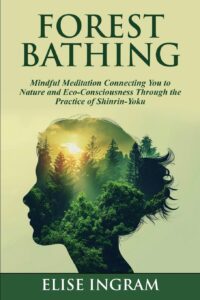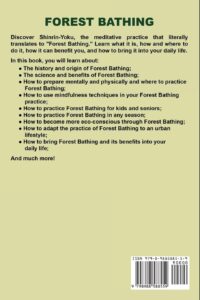In today’s hyper-connected world, where screens dominate our attention and urban landscapes define our surroundings, an ancient practice from Japan offers a powerful antidote to modern stress. Shinrin-Yoku—literally “forest bathing”—invites us to immerse ourselves in nature not as a form of exercise or outdoor recreation, but as a therapeutic practice with remarkable health benefits supported by a growing body of scientific research.

What Exactly Is Shinrin-Yoku?
Shinrin-Yoku emerged in Japan during the 1980s as a response to the country’s tech boom and increasing urbanization. The term was coined by the Japanese Ministry of Agriculture, Forestry, and Fisheries to encourage people to reconnect with their country’s abundant forests.
Unlike hiking or other outdoor activities with fitness goals, Shinrin-Yoku is about presence and sensory immersion. The practice involves slowly walking through a forest environment, mindfully engaging all five senses: the scent of pine and soil, the sound of rustling leaves and birdsong, the feel of bark and moss beneath your fingertips, the sight of dappled sunlight filtering through the canopy, and even the taste of fresh forest air.
Tomohide Akiyama, who helped develop the concept, described it as “bathing in the forest atmosphere.” It’s about allowing nature to enter through your senses, bridging the gap between our increasingly indoor lives and our evolutionary connection to natural environments.
The Science Behind Forest Bathing
veloped into a robust field of scientific research. Studies from Japan, South Korea, the United States, and Europe have documented numerous physiological and psychological benefits of Shinrin-Yoku.
Immune System Enhancement
One of the most remarkable discoveries comes from research led by Dr. Qing Li, Chairman of the Japanese Society for Forest Medicine. His studies found that forest bathing increases natural killer (NK) cell activity, a crucial component of our immune system that helps fight cancer and viral infections.
These immune benefits aren’t just immediate—they can last for weeks after a forest visit. Dr. Li’s research showed that after a three-day forest bathing trip, participants’ NK cell activity increased by 50%, with effects lasting more than 30 days.
Phytoncides: Nature’s Immune Boosters
What causes these immune benefits? Scientists believe phytoncides—aromatic compounds released by trees and plants—play a key role. These natural oils, which give forests their characteristic smell, contain antimicrobial properties that help plants defend against insects and disease.
When humans inhale phytoncides during forest bathing, these compounds appear to stimulate our immune function. Cypress, cedar, oak, and pine trees are especially rich in these beneficial compounds.
Stress Reduction and Mental Health
The stress-reducing effects of forest bathing are among its most well-documented benefits. Multiple studies have demonstrated significant decreases in cortisol (the primary stress hormone) levels after forest bathing sessions.
Research published in the journal Environmental Health and Preventive Medicine found that participants who spent time forest bathing showed a 12.4% decrease in cortisol compared to urban walkers. They also exhibited lower blood pressure, pulse rate, and reduced sympathetic nervous system activity (associated with “fight or flight” responses).
Beyond physiological markers, forest bathing has been shown to:
- Decrease symptoms of depression and anxiety
- Reduce rumination and negative thought patterns
- Improve mood and feelings of vitality
- Enhance focus and concentration
- Increase feelings of awe and gratitude
A 2019 study in Scientific Reports found that people who spent at least 120 minutes per week in nature reported significantly better health and psychological well-being than those who didn’t connect with natural environments.
Cardiovascular Benefits
The cardiovascular system responds positively to forest environments. Research published in the Journal of Cardiology found that forest bathing reduced blood pressure in people with hypertension. Other studies have documented:
- Decreased heart rate
- Reduced systolic and diastolic blood pressure
- Improved heart rate variability (an indicator of cardiac health)
- Lower levels of stress hormones that can damage blood vessels
These benefits appear particularly pronounced in individuals with pre-existing cardiovascular conditions, suggesting forest bathing could be a valuable complementary therapy for heart health.
Better Sleep Quality
In our sleep-deprived society, forest bathing offers natural support for healthy rest. Research indicates that time spent in forests can help regulate circadian rhythms—our internal body clocks that govern sleep-wake cycles.
Natural light exposure, especially in the morning, helps synchronize our circadian rhythms, while the reduction in stress and mental fatigue from forest bathing creates ideal conditions for deeper, more restorative sleep. A study in the Journal of Sleep Research found that participants reported improved sleep quality and duration following regular forest bathing sessions.
Cognitive Benefits and Attention Restoration
In 1989, psychologists Rachel and Stephen Kaplan proposed Attention Restoration Theory, suggesting that natural environments help restore our directed attention capacity—the cognitive resource we use for concentration that becomes depleted with mental fatigue.
Modern research has validated this theory. A 2019 study in Scientific Reports used functional MRI to observe brain activity during exposure to natural versus urban scenes. The nature exposure activated brain regions associated with positive emotional processing and reduced activity in areas linked to stress and emotional distress.
Other cognitive benefits include:
- Enhanced creativity and problem-solving abilities
- Improved working memory performance
- Better cognitive flexibility
- Reduced mental fatigue
- Enhanced ability to focus on tasks
How to Practice Shinrin-Yoku
The beauty of forest bathing lies in its simplicity. Unlike many wellness practices that require special equipment or training, forest bathing is accessible to almost everyone. Here’s a comprehensive guide to practicing Shinrin-Yoku:
Finding Your Forest
While traditional Shinrin-Yoku takes place in forests, you can adapt the practice to various natural settings:
- Local woodlands or forests
- Botanical gardens
- Parks with sufficient tree cover
- Tree-lined walking paths
- Arboretums or nature preserves
The ideal environment provides a sense of immersion in nature, relatively free from urban noise and distractions. Look for places with diverse plant life, especially coniferous trees that release beneficial phytoncides.
The Practice
- Leave technology behind: Turn off your phone or leave it behind if possible. This practice is about disconnecting from digital distractions.
- Enter with intention: Set an intention to be present with the forest. This isn’t a hike or exercise—it’s about communion with nature.
- Move slowly: Walk at a pace that allows full sensory engagement, typically no more than one mile in two to four hours.
- Breathe deeply: Practice deep, abdominal breathing to enhance relaxation and phytoncide inhalation.
- Engage your senses:
- Sight: Notice colors, patterns, light, and movement. Look up at the canopy, down at the forest floor, and all around at different scales.
- Sound: Listen to birdsong, rustling leaves, flowing water, and the sound of your own breathing. Try closing your eyes to enhance auditory perception.
- Touch: Feel different textures—rough bark, smooth stones, soft moss, cool water. Walk barefoot if conditions permit.
- Smell: Inhale deeply through your nose, noting the earthy, fresh scents. Try to distinguish different aromas.
- Taste: If you’re knowledgeable about wild edibles, safely taste forest foods. Otherwise, simply notice the taste of the air as you breathe.
- Find a “sit spot”: Choose a comfortable place to sit quietly for 20-30 minutes, allowing the forest to envelop you.
- Practice mindful attention: When your mind wanders, gently bring attention back to sensory experience.
- Express gratitude: End your session by thanking the forest for the experience.
Optimal Duration and Frequency
Research suggests that the ideal forest bathing session lasts between two to four hours for maximum benefits, though positive effects begin after just 20 minutes.
For sustained benefits, try to practice Shinrin-Yoku at least twice monthly. Those with high-stress lifestyles or health concerns may benefit from weekly sessions.
Integrating Forest Bathing into Healthcare
Recognizing the evidence-based benefits of forest bathing, medical professionals around the world are beginning to incorporate nature therapy into treatment plans.
In Japan, there are now 62 designated forest therapy bases where doctors can send patients with a “forest prescription.” In the United States, organizations like the Association of Nature and Forest Therapy train guides who work with healthcare providers to offer structured forest bathing experiences.
Forest bathing is proving particularly valuable as a complementary therapy for:
- Stress-related disorders
- Mild to moderate depression and anxiety
- High blood pressure
- Sleep disturbances
- Attention deficit disorders
- Recovery from surgery or illness
- Cancer prevention and recovery support
Dr. Robert Zarr, a pediatrician in Washington D.C., founded “Park Rx America,” a physician-led program that encourages doctors to prescribe time in nature. The program now includes over 10,000 parks in its database and has spread to multiple states.
Forest Bathing in the Modern World
As our lives become increasingly digital and indoor-focused, the practice of forest bathing offers a vital counterbalance. The COVID-19 pandemic only heightened our collective awareness of the importance of nature connection, as people worldwide turned to outdoor spaces for solace and safety.
Even in highly urbanized environments, opportunities for modified forest bathing exist. Urban planners and public health officials are increasingly recognizing the importance of accessible green spaces as essential components of healthy cities.
Companies are also beginning to incorporate forest bathing into wellness programs, recognizing the benefits for employee well-being and productivity. Research shows that even brief nature experiences can reduce stress and improve cognitive performance in the workplace.
A Prescription for Modern Life
In a world where burnout, chronic stress, and lifestyle diseases have reached epidemic proportions, Shinrin-Yoku offers a remarkably simple yet profound intervention. It requires no special equipment, no membership fees, and no technological gadgets—just a willingness to slow down and connect with our evolutionary home.
As the scientific evidence continues to mount, forest bathing stands as a powerful reminder that our health is inextricably linked to the natural world. Perhaps the forests have been offering their medicine all along—we just needed to remember how to receive it.
The next time you feel overwhelmed, exhausted, or disconnected, consider writing yourself a prescription for forest time. Your mind, body, and spirit will thank you as you rediscover the healing power that awaits beneath the canopy.
Remember: While forest bathing offers significant health benefits, it should complement rather than replace conventional medical care. If you have serious health concerns, consult with healthcare professionals about how nature therapy might support your treatment plan.
Hey there! We hope you love our fitness programs and the products we recommend. Just so you know, Symku Blog is reader-supported. When you buy through links on our site, we may earn an affiliate commission at no extra cost to you. It helps us keep the lights on. Thanks.
Disclaimer: The information provided in this discussion is for general informational and educational purposes only. It is not intended as medical or professional advice. Only a qualified health professional can determine what practices are suitable for your individual needs and abilities.



Pingback: Embracing the Dark Can Transform Your Mental Health - Symku's Blog